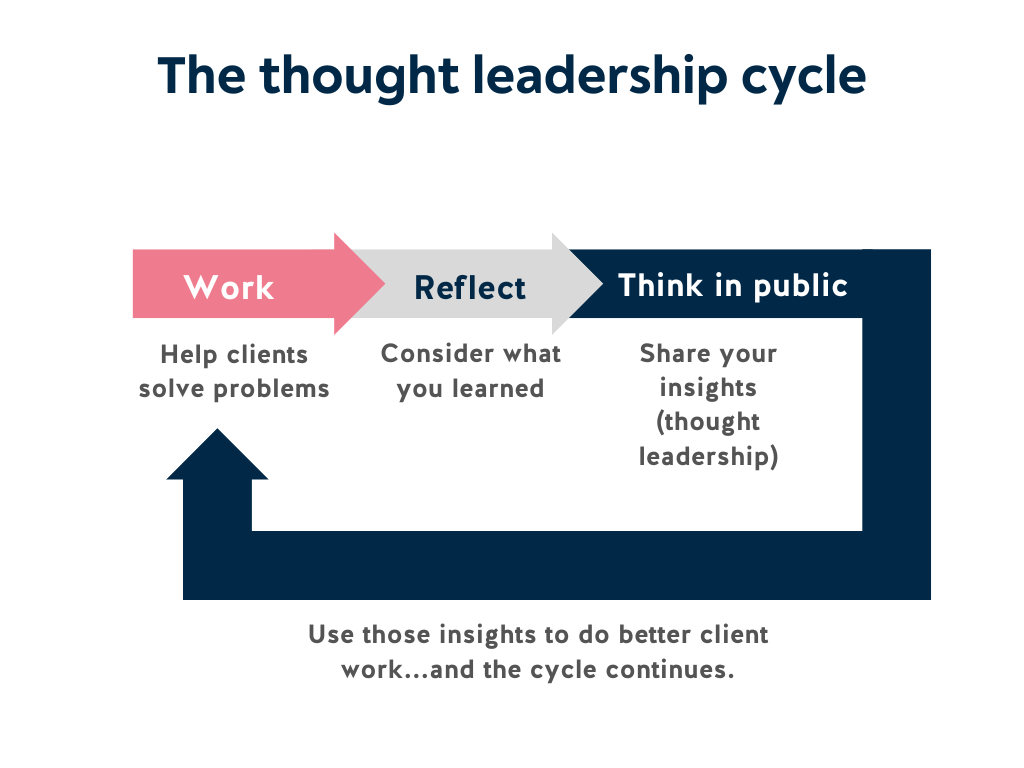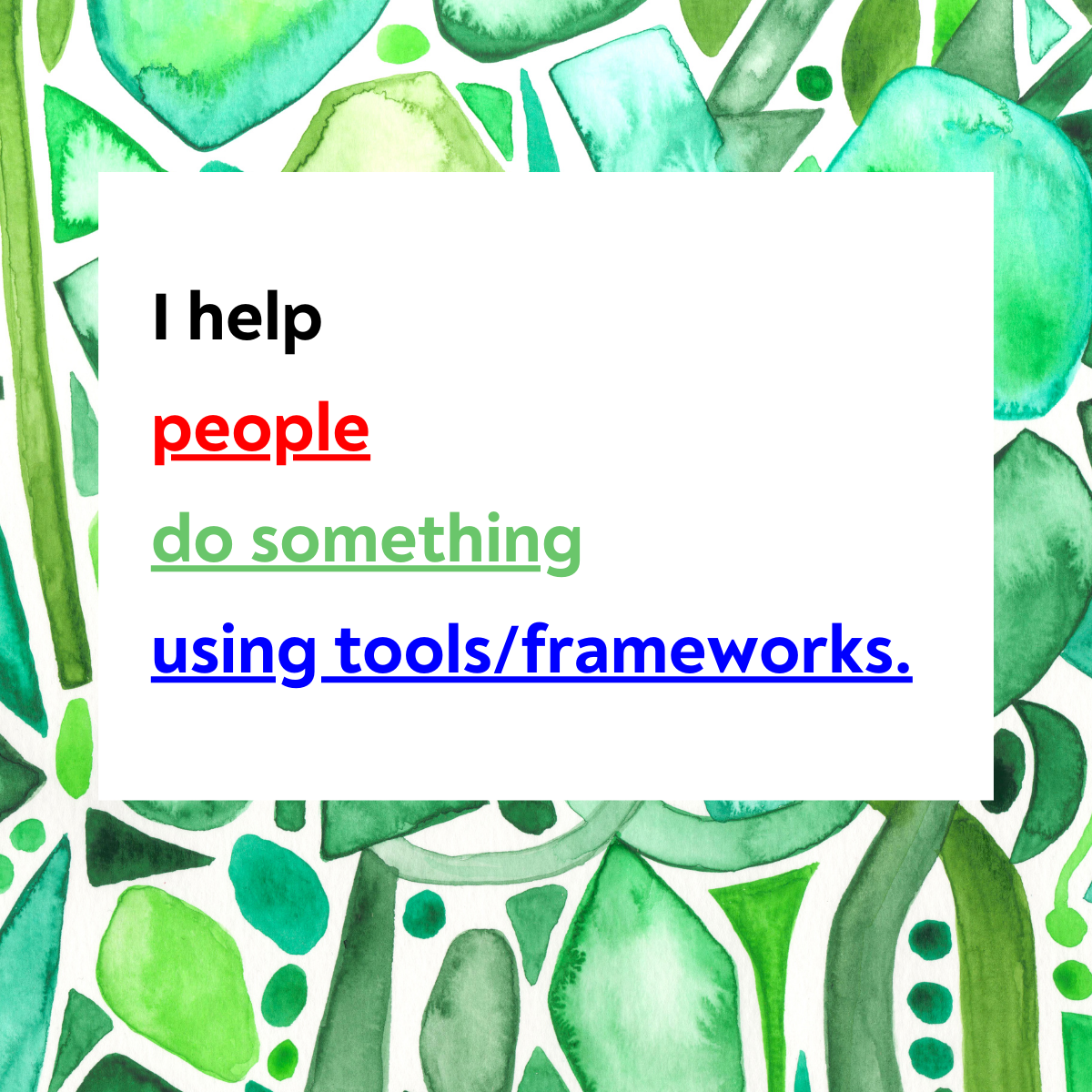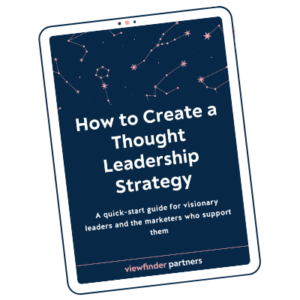What’s your thought leadership strategy?
You might not be sure how to answer that question. You might think your thought leadership strategy is “LinkedIn.” Or “email.” Or “I’ve always thought I had a book in me…” Or if you like speaking, it could be “maybe I’ll get back on stage soon…”
When I ask about strategy, most thought leaders immediately think about the tools they’ll use to share their ideas. And while LinkedIn, email, books, and speaking are all useful tools to get your message in front of your audience, the tools themselves don’t matter at all if you aren’t clear on the ideas.
Who are you, who are you talking to, what are you helping them think about, and what makes your ideas unique? Why do people look to you for guidance, expertise, or inspiration?
I recently started using a new framework with B2B thought leaders. I call it the one-sentence thought leadership strategy, and it cuts right to the heart of what matters most.
It usually takes me several weeks to develop this single sentence with a thought leader, but I’ll outline the process we use to build it. If you’re developing your thought leadership strategy for a new year, a new season of work, or a new thought leadership platform, I hope this is useful.
Let’s get started!
Know the formula
Here’s the sentence structure you’re going to build:
I help
people
do something
using tools/frameworks.
This sentence is really about defining your work. Because thought leadership is sharing your work and your thought process in public, you have to know your work — what sets it apart and makes your approach special — to talk about it. The thought leadership cycle is powered by reflection.

The formula for the sentence itself doesn’t hold any power. The meaning comes from defining each part of that sentence…keep reading.
Answer these three questions about your thought leadership
The one-sentence strategy is built on your answers to three questions about your thought leadership:
-
- Who is your audience? Who are the people you serve through your work?
- What do you help people do/think about/accomplish/change?
- How is your approach or your perspective unique? What sets you apart from the market?
Instead of giving pat answers to these questions, I encourage you to really dig in and develop specific answers.
Here’s an example. Let’s say you’re an executive coach.
Who do you serve?
On the surface, maybe you work with “executives.” But what kind of executives? What does “executive” really mean? Who are the clients who are most ideally suited to your style and the results you deliver? Do you work with new leaders? Women of color? Managers who need help guiding team dynamics? People who are in transition and looking for a new role? C-level leaders at public companies? Nonprofit directors? Who are your people, specifically?
What do you help them do?
Make a list of all of the ways you help the people you serve. Do you help them take back control of their work day? Define their 5-year career plan? Overcome imposter syndrome? What are the problems they bring to you, and how do you help them solve those problems?
How is your approach unique?
Here’s where your secret sauce comes in. This is the most critical part of your one-sentence strategy. What’s your perspective? What makes you different than everyone else who does similar work? Do you have core frameworks or systems that power your work? Are there specific experiences in your career that have shaped your approach?
If you’re stuck on this part, try brainstorming a list of adjectives that describe your work. Are you serious? Creative? Unorthodox? Do you subscribe to a particular school of thought (or reject the status quo)? Defining your unique approach will help you market yourself — and give you a jumping-off point to power your thought leadership content.
Build your one-sentence strategy
Once you’ve answered those three questions, you know:
- your audience.
- what future state you’re trying to take them to / what problem you’re helping them solve.
- what differentiates you from everyone else.
And you can fill in your one-sentence strategy using the formula:
I help
people
do something
using tools/frameworks.
That final blue part of your sentence is where all of your thought leadership content will bloom. It’s your unique framework, your way of doing things, and your core principles. The blue part is the big ellipsis of the sentence. It’s your open-ended invitation to tell people more about how you think and how you work.
Continuing the example of the executive coach, their sentence might be:
I help
newly promoted nonprofit leaders
find their leadership style to motivate resource-strapped teams
using an empathetic approach rooted in emotional intelligence.
Saying you’re a “coach” or a “business consultant” doesn’t mean much. Similarly, saying “I want to write a book” or “we want to make a podcast” doesn’t tell us much about who you’re making it for, or why you’re making it. But when you have created this one-sentence strategy, your work and your thought leadership have a clear perspective and a specific direction.
Distilling your thought leadership strategy into a simple sentence will open the door for big ideas that directly serve the people who matter most in your work.







